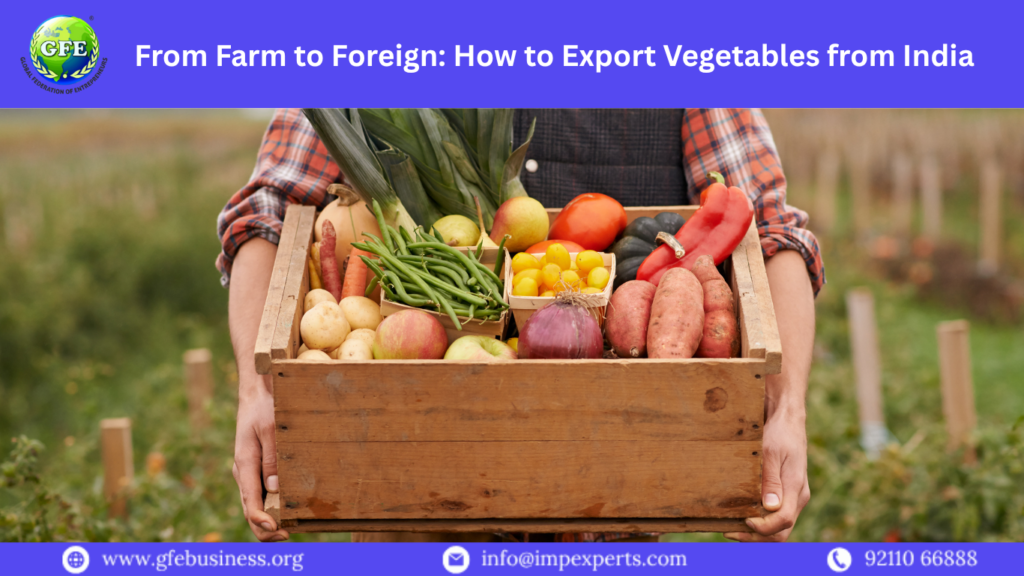India is one of the largest producers of fresh vegetables in the world — and global demand for Indian produce is only growing. From okra to green chili and from drumsticks to leafy greens, countries like the UAE, UK, and Saudi Arabia are eager importers. But how do you actually start a vegetable export business from India?
At GFE Business, we guide farmers, traders, and agri-entrepreneurs through every step of the export process — so they can turn their local harvest into global revenue.
Step 1: Register Your Business for Exports
To start exporting vegetables, you’ll need:
IEC (Import Export Code) from DGFT
GST Registration for your firm or business
FSSAI License for food-grade export
Current Account with AD code registration (with your bank)
Once you’re legally ready, you can move on to sourcing and compliance.
Step 2: Source Export-Grade Vegetables
Not all vegetables are suitable for export — buyers demand quality, consistency, and hygiene. Focus on:
Fresh, uniform produce (size, color, ripeness)
Cold chain logistics-ready crops (okra, capsicum, drumsticks)
Residue-free or organic certification (for EU & US markets)
If you’re a farmer, ensure GAP (Good Agricultural Practices) are followed. If you’re a trader, tie up with farms that meet these standards.
Step 3: Understand the Market Demand
Before you export, research where your vegetable is in demand. For example:
UAE & Saudi Arabia import green chillies, bitter gourd, cluster beans
UK & Germany import okra, ginger, curry leaves, eggplant
USA & Canada import drumsticks, tindora, and fresh coriander
Use tools like APEDA’s Agri Exchange, B2B platforms (e.g., Alibaba, Tradewheel) and buyer directories.
Step 4: Manage Packaging, Grading & Cold Chain
The shelf life of vegetables is short. Ensure:
Grading is done based on export standards
Packaging is breathable, reusable, or vacuum-sealed (for air cargo)
Cold chain is maintained till final delivery
Labels are printed as per destination country standards
This reduces rejection rates and increases your chances of getting repeat buyers.
Step 5: Choose Sea or Air Freight
Vegetables are mostly sent by:
Air cargo: Faster, costlier, ideal for leafy greens, okra, chillies
Reefer containers via sea: Cost-efficient for bulk items like potatoes, onions, frozen vegetables
Work with a freight forwarder who understands perishable cargo documentation, including phytosanitary certificates, COO, invoice, packing list, shipping bill, etc.
Step 6: Find Genuine Buyers
Use a combination of these channels:
B2B sites: Alibaba, TradeIndia, Global Sources
WhatsApp/Email prospecting using buyer lists
Exporter groups, trade expos, and APEDA events
LinkedIn + cold email with digital catalogs
Follow-up is key. Most exporters succeed after 3–5 buyer interactions.
How GFE Business Supports You
GFE Business has helped hundreds of first-time exporters start vegetable exports by offering:
Practical training with real formats
Documentation and setup support (IEC, FSSAI, AD Code)
Buyer search strategy + message templates
Ongoing mentorship for product selection & pricing
Local support in Gujarat, Maharashtra, West Bengal, and beyond
We train you not just to learn — but to launch with clarity.
Final Words
Starting a vegetable export business from India can be one of the most profitable, low-investment ventures — if done with the right planning and product knowledge. From farm to foreign, it’s all about process, paperwork, and persistence.
Ready to export vegetables from India and grow your business globally?
Visit www.gfebusiness.org and connect with real trade opportunities.
